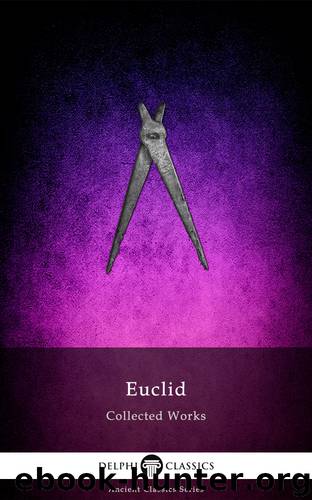Collected Works of Euclid by Euclid

Author:Euclid [Euclid]
Language: eng
Format: epub, mobi
Tags: Ancient Classics
Publisher: Delphi Classics
Published: 2019-09-19T16:00:00+00:00
Now, with AB remaining in its place, if the triangle BGK is revolved about the right angle K, and is restored to the same position from which it started, the line BG will touch the sphere at one point and the line KG will make a circular section. So, an arc will be seen in the sphere. And I say that it is less than a hemisphere. For, since LT is a semicircle, GD is less than a semicircle. And the same part of the sphere is seen by the rays BG and BD. So, GD is less than a hemisphere; and it is seen by the rays BG and BD.
When the eye approaches the sphere, the part seen will be less, but will seem to be more. (Fig. 24.)
Let there be a sphere, of which the center is A, and let the eye be B, from which let the straight line AB be drawn. And around AB let the circle GBD be inscribed, and from the point A let the straight line EZ be drawn, perpendicular to the straight line AB in either direction, and let the plane be produced along EZ and AB. So it will make a circular section. Let it be GEZD, and let GA, AD, DB, BG, and GD be drawn. So, according to the theorem given before, the angles at the points G and D are right angles. Thus, BG and BD, whatever rays there are, touch the sphere. And the part of the sphere, GD, is seen by the eye, B. Now let the eye he moved nearer to the sphere, and let it be at T, from which let the straight line TA be drawn, and let the circle ALK be inscribed, and let the straight lines TK, KA, AL, and LT be drawn. Now, similarly, by the eye at T is seen the part of the sphere, KL, and by the eye at B the part GD was seen. And KL is less than GD. So, as the eye approaches, the part seen is less. But it seems to be more; for the angle KTL is greater than the angle GBD.
When a sphere is seen by both eyes, if the diameter of the sphere is equal to the straight line marking the distance of the eyes from each other, the whole hemisphere will be seen. (Fig. 25.)
Let there be a sphere, of which A is the center, and on the sphere let the circle BG be inscribed about the center A, and let BG be drawn as its diameter, and at right angles from B and G let lines be drawn, BD and GE, and let DE be parallel to BG, and upon this (DE), let D and E represent the eyes. I say that the complete hemisphere will be seen. Through A let AZ be drawn parallel to each of the lines, BD and GE; then ABZD is a parallelogram. Now, if the inscribed figure is revolved and then restored
Download
This site does not store any files on its server. We only index and link to content provided by other sites. Please contact the content providers to delete copyright contents if any and email us, we'll remove relevant links or contents immediately.
| Applied | Geometry & Topology |
| History | Infinity |
| Mathematical Analysis | Matrices |
| Number Systems | Popular & Elementary |
| Pure Mathematics | Reference |
| Research | Study & Teaching |
| Transformations | Trigonometry |
Modelling of Convective Heat and Mass Transfer in Rotating Flows by Igor V. Shevchuk(6391)
Weapons of Math Destruction by Cathy O'Neil(6143)
Factfulness: Ten Reasons We're Wrong About the World – and Why Things Are Better Than You Think by Hans Rosling(4694)
Descartes' Error by Antonio Damasio(3230)
A Mind For Numbers: How to Excel at Math and Science (Even If You Flunked Algebra) by Barbara Oakley(3217)
Factfulness_Ten Reasons We're Wrong About the World_and Why Things Are Better Than You Think by Hans Rosling(3199)
TCP IP by Todd Lammle(3134)
Fooled by Randomness: The Hidden Role of Chance in Life and in the Markets by Nassim Nicholas Taleb(3044)
Applied Predictive Modeling by Max Kuhn & Kjell Johnson(3018)
The Tyranny of Metrics by Jerry Z. Muller(3000)
The Book of Numbers by Peter Bentley(2912)
The Great Unknown by Marcus du Sautoy(2646)
Once Upon an Algorithm by Martin Erwig(2598)
Easy Algebra Step-by-Step by Sandra Luna McCune(2583)
Lady Luck by Kristen Ashley(2533)
Practical Guide To Principal Component Methods in R (Multivariate Analysis Book 2) by Alboukadel Kassambara(2497)
Police Exams Prep 2018-2019 by Kaplan Test Prep(2484)
All Things Reconsidered by Bill Thompson III(2355)
Linear Time-Invariant Systems, Behaviors and Modules by Ulrich Oberst & Martin Scheicher & Ingrid Scheicher(2333)
